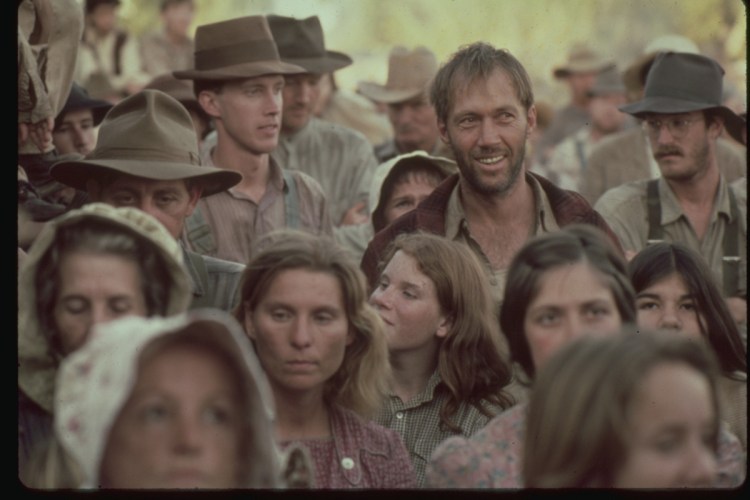“Bound for Glory,” Hal Ashby’s incredible and colorful story of the American troubadour Woody Guthrie, should be a staple of film festivals each summer for at least the next 10 years.
“Bound for Glory” was nominated for best picture of 1976, but researching that year for this review, I discovered that 1976 was the year that featured a decade’s worth of great films. “All the President’s Men,” “Taxi Driver” and “Network” were all up for the gold as well, but even those great films were shunted aside for the story of an Italian boxer, written by Italian actor-writer Sylvester Stallone.
“Rocky” knocked them out. Ain’t it always the way.
Guthrie’s story and his fights for the “real folks” and unions had been part of America’s pastoral legends long before Ashby’s film was made, but it needed some brushing off and color to bring Guthrie’s life back into focus at a time in America when his words and images ring truest.
The late David Carradine is our Guthrie here, and a better choice could not have been made. Many were called, but only one was chosen.
Ashby’s touch here is strong and loving. It is based on Guthrie’s 1943 autobiography, “Bound for Glory,” and the key word here is authenticity — not just in the costumes and architecture, which are amazing; but in the manner each actor handled his and her roles.
Haskell Wexler, the legendary cinematographer (“Coming Home,” “In the Heat of the Night”), must get full credit for what we see on the screen.
Not even John Ford’s “Grapes of Wrath,” the great story of the Joad family and their exodus from the parched dust bowl of Oklahoma, starring Henry Fonda, so accurately etched the details of American life in the Great Depression.
But then Ford didn’t have Wexler.
Ashby is credited with “richly detailing” Guthrie’s life in the film, but having read much of Woody’s book, I find that many details of his journey were left out, especially the womanizing he indulged in on his dusty road to fame.
We meet Woody in 1936, when he is only 20 years old, already married and father of two children, tired of eking out a living as a sign painter, dance hall entertainer and amateur “mind reader,” in Pampa, Texas. He leaves his family with in-laws and hitchhikes down that now famous dusty road across America to find eventual fame on radio, in print and music.
Pampa was only the beginning. The list of friends and road buddies who also became famous in that era is a long one, like Will Geer, another political activist, who became best known for his “grandpa” in television’s “The Waltons.” Ashby doesn’t spend any time detailing Woody’s political activism — that’s a book of its own — but concentrates on the more cinematic road years.
That was a good idea, but most critics agree that he should have listened more often to his editors Pembroke Herring and Robert Jones. Ashby takes his good time getting Woody from Pampa, Texas, to “the Gulf Stream waters,” and by the time we get to the “New York Highlands,” having passed through frighteningly authentic hobo camps and boxcar fights, we’re ready for a couple of beers.
Carradine pleases us with a sweet, gentle Woody who smiled often and treated all with homespun love, but I think it’s John Steinbeck’s memory of Woody that sticks with me and rings true for all of us in our troubled America today.
“There is nothing sweet about Woody,” Steinbeck said, “and there is nothing sweet about the songs he sings. But there is something more important for those who still listen. There is the will of a people to endure and fight against oppression. I think we call this the American spirit.”
Amen.
J.P. Devine, of Waterville, is a former stage and film actor.
Send questions/comments to the editors.




Comments are no longer available on this story